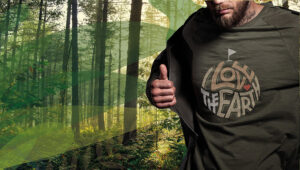 Charlotte Darling, director at Amaya Sales UK, explains why DTG printing is the most sustainable solution and why it continues to gather pace in the textile industry.
Charlotte Darling, director at Amaya Sales UK, explains why DTG printing is the most sustainable solution and why it continues to gather pace in the textile industry.
Over the years that the textile industry has evolved and decoration and or customisation has been demanded, manufacturing and printing processes have been improved and developed to offer better quality product with faster and more efficient production.
The industry has adapted to fashion trends, kept up with current technology innovations, used different raw materials, substrates, and techniques. The textile industry is the backdrop to the garment decoration industry we all find ourselves in and direct to garment (DTG) printing has been developing for nearly two decades now.
Direct to garment printing, as the name suggests, is a textile process that prints the design directly to the fabric using inkjet technology. DTG has fast become one of the most convenient methods of garment decoration, but more importantly the most sustainable and eco-friendly approach. This environmental contribution is responding to the rising demand for more ecologically conscious textile production.
The fashion industry is considered one of the largest polluters globally, as it produces about 20% of the world’s wastewater and is accountable for 10% of global greenhouse gas emissions. Annually, over 150 billion garments are produced, while each American disposes of approximately 32kg and each European around 11kg of fabrics per year. DTG printing recognised the environmental impact that common textile practices can have and came through with a responsible solution.
But rather than just spouting on about eco-friendly this and that, below I try to explain why direct to garment printing is a must for your business and the future for us all, by outlining its key advantages.
Water-based inks
DTG technology uses water-based pigment inks that consist mainly of water, making them an excellent candidate for biodegradable decomposition.
These inks are considered eco-friendlier compared with other inks and dyes, as they contain natural pigments and environmentally friendly chemical additives that have little to no VOCs emissions. The inks and pre-treatment solutions carry green certifications and are all both environmentally friendly and safe to the skin and children.
Natural fabrics
DTG printing can cover a wide spectrum of fabric types, from cotton, blends and even pure synthetics when combined with other methods (direct to fabric) or at the industrial level using an additional step. It performs best on natural fibres like cotton, linen, hemp, and leather. Organic cotton is one of the most sustainable choices for DTG printing.
Choosing a natural fibre over a synthetic one can have a great environmental impact. The biodegradability of the fabric can be vast from a few weeks (natural fibres) to even 200 years (polyester) when composted. Also, when washing synthetic fabrics tons of microfibers are released in the ocean putting marine life at risk. DTG technology was developed around the natural fabric movement, making the process more responsible and sustainable.
Print on-demand reduces waste
The fast and efficient way to decorate a garment adds to the sustainability of DTG. Printing on demand reduces stocks, creates zero waste, offers design diversity and is risk adverse. In many cases the garment is only printed when the customer has chosen to buy it, a vast difference from the outdated business model of over consumption. Your supply chain is controlled, lead times are shorter, and production is usually brought closer to the end consumer.
It is mostly an automatic process, requiring minimum user handling and this way, gives consistent high-quality prints. During production the chance of a mistake is limited as a well-maintained printer will produce good results every time, plus the various workflow solutions available on the market make the uploading of the correct design human error proof. In addition, most DTG printers have regulated the ink waste during the cleaning cycle to the minimum, to not pollute the environment with unnecessary waste.
User-friendly
The working conditions in a DTG workspace are considered one of the safest choices in the textile industry, as the print operator doesn’t come in contact with hazardous chemicals.
As mentioned before, the inks and pre-treatment liquids used are water-based, with certifications that declare they are not harmful. The inks are always kept in closed cartridges or sealed bottles and the pre-treatment solutions are sprayed within separate closed chambers or at industrial level within a one-step process, making the air that the operator breathes as safe as possible.
When in comparison with other printing or dyeing methods, DTG garments do not require an aftertreatment process. In the clothing industry, most textiles after their original treatment need a large amount of water and detergent to remove chemicals and additives, such as softener, to provide the desired feel. A DTG printed garment is ready-to-wear straight after it is cured.
So, if you are looking to expand your business into a different type of printing, make sure DTG is upmost in your mind.
 Printwear & Promotion The Total Promotional Package
Printwear & Promotion The Total Promotional Package




